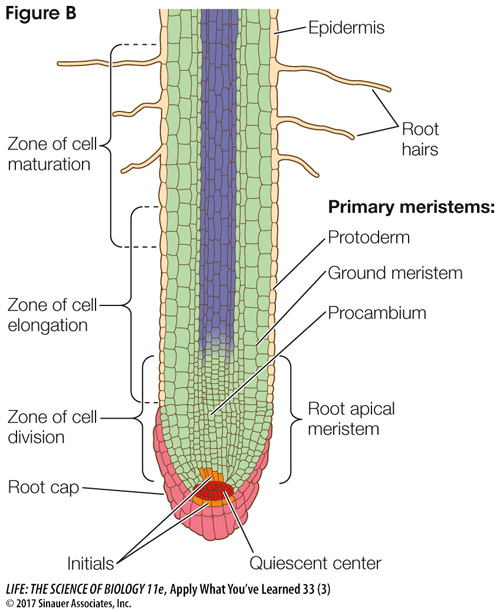Apply What You’ve Learned
Review
33.3
Growth in plants can be either determinate or indeterminate, depending on the organ structure.
33.3
At the root meristem, zones of cell division, elongation, and maturation (differentiation) form the tissues of the root and root cap.
33.3
The root consists of several tissue layers outside of the inner vascular tissues. These tissues have different arrangements in eudicot and monocot roots.
33.3
Growth in terms of cell numbers occurs at meristems.
Original Paper: Doerner, P. 1998. Root development: Quiescent center not so mute after all. Current Biology 8: R42–
Angiosperm root tissues are arranged in a cylinder with layers oriented from outside to inside and with a vascular cylinder composed of xylem and phloem in the center, as shown in Figure A.

These tissue layers originate in root apical meristems from a small, rapidly dividing group of cells called “initials,” located just above the root cap. Like stem cells in animals, initials are generalized and can differentiate into all types of plant tissues. The small group of initials surrounds a smaller group (usually four to eight cells) called the quiescent center (QC), where cells divide very slowly, as shown in Figure B. For example, in corn (Zea mays), QC cells divide every 170 hours, while those in the zone of cell division divide every 10–

To identify actively dividing cells, scientists incubate plant roots in radioactive thymidine, which enters and labels the DNA. Labeled cells are detected by a photographic technique. The table below shows simulated data for corn seeds incubated in radioactive thymidine for two hours and then removed to water containing non-
| Radioactive cells/total cells | ||||
|---|---|---|---|---|
| Number of hours after transfer to nonradioactive thymidine | Quiescent center | Initials (zone of division) | Zone of elongation | Zone of maturation |
| 0 | 1/4 | 75/95 | 0/30 | 0/19 |
| 12 | 1/4 | 85/90 | 12/32 | 0/23 |
| 36 | 1/4 | 55/110 | 15/31 | 11/21 |
| 72 | 1/4 | 3/98 | 3/29 | 28/30 |
| 144 | 1/4 | 0/108 | 0/30 | 29/31 |
| 192 | 1/4 | 0/100 | 0/27 | 30/31 |
Questions
1.
Why does the number of labeled cells in the zones of division and elongation decrease over time?
The cells are incubated in radioactive thymidine for 2 hours, during which dividing cells take up the radioactive substance and incorporate it into their DNA. After the cells are removed and placed in nonradioactive thymidine, dividing cells take up the nonradioactive substance. Thus cells dividing more than 2 hours after the start of the experiment will not be labeled. As cells formed in the first 2 hours begin to elongate and mature, the cells are pushed up the root by the new cells being made. As cells move from the zone of division to the zone of elongation, the number of labeled cells in the zone of division decreases. As cells move from the zone of elongation to maturation, the number of labeled cells in the zone of elongation decreases.
2.
Based on the distribution of labeled cells in the table, what can be inferred about the direction and pattern of root growth in this plant?
The number of labeled cells increases first in the zone of division, then in the zone of elongation, and finally in the zone of maturation. This indicates that root cells are added at the bottom by cell division. The cells then grow and elongate the root, then finally differentiate into the various tissue types that make up the mature root. Many cells are present in the zone of division, as the initials divide. It takes time for these new daughter cells to grow and move up the root, as they are pushed by newly formed cells below them.
3.
Plant cells, unlike animal cells, do not migrate during embryogenesis. Given this situation, how might the small group of initials just above the root cap result in separate layers of root tissue arranged in a cylinder?
Initials in specific locations grow up from their original locations in the meristem, with the initials forming epidermal cells located on the outside, those forming the cortex inside this, and those forming transport tissues nearest the center. These regions form the protoderm, ground tissue, and procambium, which are the precursors that differentiate into all types of root tissue. As they grow upward without migrating, the tissues naturally orient into a cylinder with several layers of cells.
4.
Researchers have suggested that the QC serves as a “stem cell reservoir” that replenishes initials and ensures the continued existence of the root apical meristem. Does the pattern of labeling in the QC over time support this hypothesis? Explain your answer.
Cells in the QC divide very slowly; in this experiment, a single cell was dividing during the first 2 hours (when labeled thymidine was present), but no more division occurred after that time. There could very well have been no division during these 2 hours, as previous experiments show that corn QC cells divide only once every 170 hours. Also, the QC contains very few cells (the exact number varies by species). This indicates that it contributes only a few cells to the growing root. These few cells might replenish initial cells lost through damage or aging, without causing excess growth of root tissue. However, this experiment does not show how (or whether) cells move from the QC to the initials.